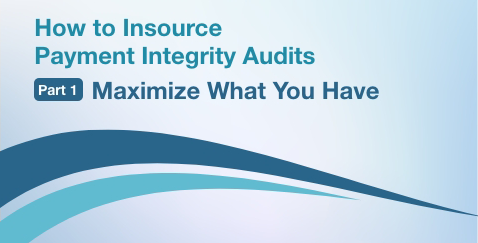
How to Insource Payment Integrity Audits

Insourcing payment integrity audits is a complex process that requires a strategic approach. We recommend a two-step method to ensure success. This blog series will guide you through this process, with Part 1 focusing on maximizing your current audit capabilities, and Part 2 exploring how to prioritize and implement new audits.
The drivers for insourcing are numerous, including cost reduction, increased control, and improved efficiency. To successfully insource audits, health plans need the ability to expand their team as needed and leverage cutting-edge technology. Let’s dive into the first step of this journey.
To begin this strategic move to enhance payment integrity management, it’s essential to evaluate which audits you are already conducting. This foundational step allows you to identify opportunities for optimization and build a roadmap for operationalizing internal audits effectively.
Maximizing Efficiency of Current Audits
Once the scope of existing audits is clear, the focus should shift to maximizing their effectiveness. It is imperative for health plans to get the most out of their teams. Here are four critical components for improving audit efficiency:
1. Enhanced Audit Selection
Refining your audit selection process is vital to ensure resources are directed toward high-value opportunities. By analyzing historical data and leveraging advanced methodologies like machine learning models, health plans can identify claims with the highest likelihood of errors or discrepancies. A targeted approach not only improves the hit rate but also minimizes unnecessary reviews, reducing provider abrasion and administrative burden.
2. Auditor Efficiency
Auditors waste valuable time sifting through spreadsheets and compiling reports manually — slowing productivity and increasing errors. These tedious tasks pull them away from what humans do best: critical reasoning and applying industry expertise.
A smart audit platform eliminates inefficiencies, freeing auditors to focus on complex decision-making, leverage their specialized knowledge, and drive deeper insights. This way there are faster, sharper, and more impactful audits.
3. Automated Workflows
Automation can revolutionize the audit process by streamlining repetitive tasks and improving accuracy. Automated workflows can:
- Prioritize claims based on risk
- Simplify document retrieval and analysis
- Reduce manual errors and inconsistencies
By integrating automation into your audit processes, you enable auditors to focus on more complex, high-impact tasks while ensuring a faster turnaround time.
4. AI-Powered Insights
Artificial intelligence (AI) can further enhance audit workflows by predicting patterns, identifying anomalies, and offering actionable insights. AI tools can support decision-making by flagging potential issues early in the process, improving both the speed and quality of audits. Generative AI can be leveraged to capture and summarize insights, and easily route audits for escalation.
Granular Reporting for Continuous Improvement
Detailed reporting is essential for evaluating the effectiveness of your audit processes and identifying areas for improvement. Comprehensive insights allow health plans to refine their strategies and address challenges proactively. Key areas of focus include:
Enhancing Audit Selection
Audit reports should provide data on success rates, enabling teams to refine their selection criteria. By understanding what works and what doesn’t, health plans can continuously improve their targeting strategies.
Identifying Bottlenecks
Detailed reporting helps uncover inefficiencies in workflows, such as delays in documentation or communication gaps between departments. Addressing these bottlenecks ensures smoother operations and faster resolution times.
Reducing Provider Abrasion
Audit results often highlight recurring issues with specific providers. Using this data to educate providers on common errors fosters collaboration and reduces friction in future audits.
Measuring Productivity
Metrics on auditor performance — such as consistency, speed, and accuracy — allow organizations to identify training needs and standardize best practices across teams.
Operationalizing Internal Audits
To operationalize internal audits effectively:
- Establish clear goals based on current audit performance.
- Invest in tools that support automation, AI integration, and detailed reporting.
- Create a feedback loop where insights from past audits inform future strategies.
- Continuously monitor outcomes to ensure alignment with organizational objectives.
By starting with an evaluation of existing audits and focusing on efficiency through enhanced selection, automation, and granular insights, health plans can successfully begin to internalize their audit processes. This approach not only improves compliance but also drives long-term operational excellence while fostering better relationships with providers.
Leveraging Centralized Platforms for Comprehensive Audit Management
When considering tools to enhance your audit processes, it’s crucial to prioritize platforms that offer centralized chart and document repositories, capable of handling multiple audit types. Here’s why:
1. Cost Efficiency
Centralized repositories eliminate the need for duplicative systems across departments like Utilization Management, Prior Authorizations, and Risk Adjustment, reducing overall costs.
2. Streamlined Access
A single repository ensures all departments have consistent access to necessary charts and documents, improving efficiency and reducing potential errors.
3. Reduced Point Solution Fatigue
By utilizing a comprehensive platform, healthcare plans can avoid the exhaustion and complexity associated with managing multiple point solutions.
4. Minimized Implementation and Maintenance Costs
A unified platform significantly reduces the resources required for implementation, training, and ongoing maintenance compared to multiple disparate systems.
5. Cross-Departmental Collaboration
Centralized systems facilitate better communication and data sharing between different audit teams, such as Payment Integrity and Quality Audit teams, who often work in separate systems.
By choosing a platform that serves as many audit types as possible and provides a centralized repository, health plans can maximize efficiency, reduce costs, and improve overall audit performance across the organization.
Tired of audit inefficiencies and missed savings opportunities? Our solution, AuditShark, delivers the comprehensive solution you need to scale your internal audit capabilities. From AI-powered insights to automated workflows, AuditShark helps you maximize productivity, accuracy, and ROI. Take control of your healthcare audits – with AuditShark.
See our AuditShark solution page to learn more





